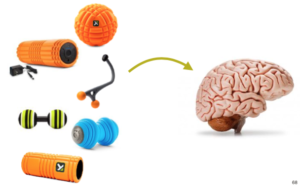by Mitch Hauschildt, MA, ATC, CSCS
For weeks now, I’ve been discussing the properties and advantages of dry needling. But, I also recognize that needling isn’t for everyone. It isn’t legal in every state and some clinical disciplines aren’t approved to dry needle. I also recognize that some clinicians aren’t comfortable dropping needles into people and some patients just aren’t good candidates for dry needling – not because it won’t work for them, but because they don’t like needles, are post-surgical, high anxiety individuals, etc. So, what do we do if we can’t needle?
There are options. I have long said that all of our tools and modalities are simply a handle into the nervous system. Our job is to figure out what handle is the best for that specific situation. Needles are simply a way to interact with the brain, just as cups, floss, IASTM tools and so on. When we look at our treatments that way, it opens the door for mixing and matching our treatments. Here are a few of the tools that I use the most when it isn’t appropriate to use dry needling.
Positional Release Therapy (PRT)
PRT has been a staple in my treatments for years. It is on the same continuum with treatment approaches such as strain-counterstrain, Active Release Therapy (ART), and trigger point release. I encourage you to avoid getting caught up in the tiny details of these treatments and explore them all to find what works well for you and your patients.
The reason I use PRT is that it is simple, doesn’t take extensive training and it is effective. It involves identifying a treatment zone (many would refer to this as a trigger point), putting pressure on that point and then taking the muscle into a shortened position and holding it for 90 seconds. I like this technique as a substitute for dry needling because it is very point specific. Meaning, I can get right into a very specific spot and work in that area (deep if I want) in a way that is effective and comfortable for the patient.
Cupping
Cupping is another good substitute for dry needling because it can also be very point specific if you desire. It works on a different mechanism (decompression vs piercing tissue), but it can have a similar effect on the nervous system. At the end of the day, the goal is to stimulate the mechanoreceptors in the fascial system (i.e. Paccinian Corpuscles, Ruffini Endings, Merkels Discs, Free Nerve Endings), and cupping can do that.
IASTM
Instrument Assisted Soft Tissue Mobilization is another technique that can be used to improvise when dry needling isn’t possible. I love IASTM for a lot of reasons, but the downside is that it can be difficult to be very point specific with tools. So in that way, it doesn’t do a great job of mimicking dry needling. But, what I do like about IASTM as a substitute for needling is my ability to affect the local tissue in different ways simply by changing the rate, depth and treatment vector as I move over top of the skin. This allows me to get as specific as I want in order to achieve my best outcome.
TriggerPoint Ball/Foam Roll
This is a bit of a stretch for me, because I don’t think that these are a good substitute for dry needling, but they are some self-care things that patients can do for themselves. I find that if patients received short term relief from these types of tools that they typically respond well to dry needling, so there is enough similarities here that I do think that they can go hand in hand.
Conclusion
Overall, I think that dry needling is a great tool that can be very effective. It isn’t for everyone, but it allows me to do some things that I can’t do without an invasive tool. I hope that you have enjoyed this series on dry needling and I hope to see you in an upcoming course. You can always feel free to reach out to me if you have questions or want to host a course.


Leave a Reply